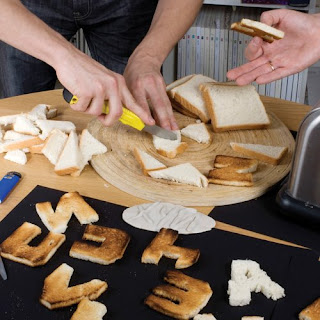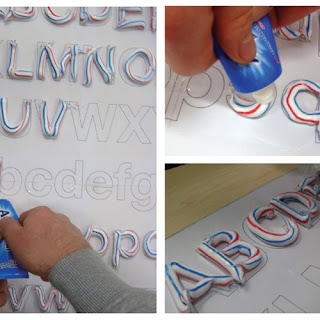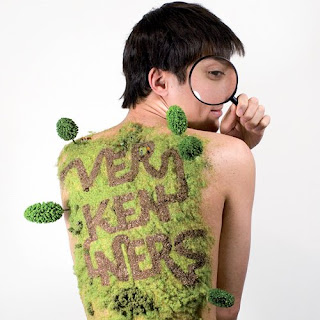



Iv chosen to compare the processes and practices of two artists working in very different fields; Patrick Thomas, an illustrator / graphic designer based in Barcelona, and Luise Vormittag, co-founder of Container Plus, a company which focuses on such diverse elements as 3d and set design, fashion photography and street art.
Thomas’s main client is the economy supplement from a Spanish newspaper, basically their equivalent to the Guardian here, for which he produces weekly cover designs and editorials. His illustrations tend to be based around a strong concept, and are very simple and direct in the way they communicate. The nature of editorial work dictates that this is the case, as most readers will only glance at an image; therefore its meaning must be bold and immediately obvious. The piece above is a good example of this clarity, it illustrates an article describing the differences between France and Germany. His ability to work in this way stems directly from his interest in the bold imagery of the punk and pop art movements of the 60s and 70s.
The vast majority of these illustrations have a strong political theme behind them, which is obviously dictated by the article, but it is something that I feel Thomas has a genuine interest in. I felt that his strongest piece was the iconic image of Che Guevara screenprinted, his face made up of corporate logos and symbols of capitalism. This appropriation of images is something that Thomas enjoys; the challenge of putting an original slant on an existing image in order to make it his own. His interest in using clichés also helps to make his images obvious in their communication. The short timescale to which he has to work seems fairly typical of editorial jobs; most images are produced in only a few hours, which informs the necessity to develop a quick way of working.
The relatively low pay of editorial work makes it essential to be prolific. The prospect of a reliable, regular job, plus the exposure that editorial work gives you as an artist seems quite attractive to me; however I think that my 3D style is too time consuming; I simply would not be able to compete with someone who uses Photoshop and can produce an image in a couple of hours. I also feel that the constraints placed on an illustrator by a publication such as a newspaper mean that there is little room for experimentation or development of style, which I personally would find pretty boring.
As an editorial illustrator, Patrick Thomas works alone, though shares his studio with other artists. Luise Vormittag works as part of a small company, and is therefore constantly collaborating with others. They describe their work as ‘hand rendered artwork, set design and photography’, and have an extensive and varied client list including Topshop, Bitburger, MTV, Selfridges, and Volkswagen. The influence of Art Noveau is combined with contemporary art and fashion, and even magazines such as Heat provide inspiration. I think that this ability to work within several disciplines and keep their work up to date with current trends makes it edgy, which in such a competitive world is a major strongpoint for the company, as there will always be a market for their work. Unlike the simplicity favoured by Patrick Thomas, Vormittag’s work is quite elegant and contains a lot of hidden detail. She uses Photoshop, but a lot of her work is hand drawn or 3d.
Both practitioners use self initiated projects as a way of developing ideas and style, and producing promotional material. Patrick Thomas has produced postcards of his screen prints, and he recently held an exhibition in which his work was appropriately displayed in a newspaper format. Self initiated projects are particularly important to Container Plus, due to the necessity of having a wide variety of fresh promotional material to use when pitching for jobs. I find the idea of working in several different disciplines very exciting, as no project would be the same and it would give my style and skills the chance to be constantly evolving. I also like the idea of being part of a team, as the necessary evils that come with running a creative business, such as admin and promotion, can be split, taking the pressure off the individual. However, I recognise the risks of being in an industry where you are pitching for the majority of your work, and the level of confidence, determination and self motivation required in order to succeed. In a way I think I can be too laid back at times. Another downside to this way of working is the cost of hiring other people such as photographers, when there is no guarantee of any income at the end of the project. If I decide to follow this path, I would be keen to learn these skills for myself.
Whether I work alone or collaborate, a lesson I can take from both practitioners is the importance of not being too insular as a designer, as a lot of inspiration can come from other people; also I think being around others in a working environment is good for motivation.
I found the visits to both Luise’s and Patrick’s studios very worthwhile; the idea of set and stage design had not occurred to me until visiting Container Plus in London. A piece from a self initiated project called ‘Footwear Fairytales’ (above) changed the way I work; rather than struggling to combine hand made and digital work, I have found more success in creating a whole image in 3D and photographing them. What I found most inspiring about visiting Patrick Thomas’s studio in Barcelona was the idea of working abroad, as I love experiencing other cultures and find it easy to pick up foreign languages.
While Patrick’s and Luise’s work differs greatly in terms of style, industry, and subject matter, I feel that they share similar attitudes in terms of loving what they do and having the confidence to do it.


















